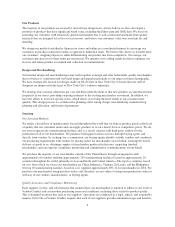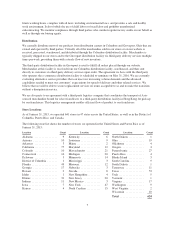Express 2014 Annual Report Download - page 19
Download and view the complete annual report
Please find page 19 of the 2014 Express annual report below. You can navigate through the pages in the report by either clicking on the pages listed below, or by using the keyword search tool below to find specific information within the annual report.The raw materials used to manufacture our products and our transportation and labor costs are subject to
availability constraints and price volatility, which could result in increased costs.
The raw materials used to manufacture our merchandise are subject to availability constraints and price volatility
caused by high demand for cotton, high demand for petroleum-based synthetic and other fabrics, weather
conditions, supply conditions, government regulations, economic climate, and other unpredictable factors. In
addition, our transportation and labor costs are subject to price volatility caused by the price of oil, supply of
labor, governmental regulations, economic climate, and other unpredictable factors.
Increases in the demand for, or the price of, raw materials used to manufacture our merchandise and increases in
transportation and labor costs could each have a material adverse effect on our cost of sales or our ability to meet
our customers’ needs. We may not be able to pass all or a material portion of such increased costs on to our
customers, which could negatively impact our profitability.
The interruption of the flow of merchandise from international manufacturers could disrupt our supply chain.
We purchase the majority of our merchandise outside of the United States through arrangements with
approximately 60 vendors, utilizing approximately 285 manufacturing facilities located throughout the world,
primarily in Asia and Central and South America. Political, social, or economic instability in Asia, Central, or
South America, or in other regions where our products are made, could cause disruptions in trade, including
exports. Other events that could also cause disruptions to our supply chain include:
• the imposition of additional trade law provisions or regulations;
• the imposition of additional duties, tariffs, and other charges on imports and exports;
• quotas imposed by bilateral textile agreements;
• foreign currency fluctuations;
• natural disasters and theft;
• restrictions on the transfer of funds;
• the financial instability or bankruptcy of manufacturers; and
• significant labor disputes, such as dock strikes.
We cannot predict whether the countries in which our merchandise is manufactured, or may be manufactured in
the future, will be subject to new or additional trade restrictions imposed by the United States or other foreign
governments, including the likelihood, type, or effect of any such restrictions. Trade restrictions, including new
or increased tariffs or quotas, embargoes, safeguards, and customs restrictions against apparel items, as well as
labor strikes and work stoppages or boycotts, could increase the cost or reduce the supply of apparel available to
us and adversely affect our business, financial condition, or results of operations.
If we encounter difficulties associated with distribution facilities or if they were to shut down for any reason,
we could face shortages of inventory, delayed shipments to our online customers, and harm to our reputation.
Any of these issues could have a material adverse effect on our business operations.
Our distribution facilities are operated by third parties. Our Columbus facility operates as our central distribution
facility and supports our entire North American business, as all of our merchandise is shipped to the central
distribution facility from our vendors and is then packaged and shipped to our stores or the e-commerce
distribution facility in Groveport, Ohio for further distribution to our online customers. The success of our stores
and the satisfaction of our online customers depend on their timely receipt of merchandise. The efficient flow of
our merchandise requires that the third parties who operate the distribution facilities have adequate capacity to
support our current level of operations and any anticipated increased levels that may follow from the growth of
our business.
15
























